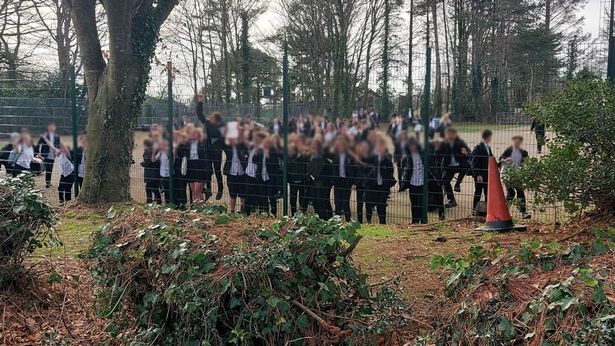By Andy Ford, Warrington South CLP
The outbreak of school student protests across England and Wales in early this month shows the level of volatility that exists in British society. Students walked out, protested, or refused instructions in more than a dozen schools around the country. Although the protests occurred ‘independently’ of each other, there is some evidence that the idea was spread by social media.
Schools affected included Rainford High School in Merseyside, Great Sankey in Warrington, Mountain Ash in Wales, Weston Secondary in Southampton, Farnley Academy in Leeds, Neale-Wade Academy Lincolnshire, Penrice Academy, St Austell, Cornwall, Homewood in Tenterden, Kent, Haven High School in Boston, Lincolnshire; Shenfield High School and Wickford School in Essex, and Richmond School in North Yorkshire (Rishi Sunak’s constituency).
Some of the protests were very disorganised and degenerated into throwing books, turning over desks, setting off fire extinguishers and the like. Allegedly, in some cases, teachers were pushed and in some schools the police were called. Two students were injured, apparently, to the extent of having broken bones. [see video from Tik-Tok of one of the protests here]
Obviously, socialists do not support any ‘protests’ that only amount to vandalism or purposeless rampages, but we should support the right to proper protest and self-organisation by students. It is also important to consider what might lie behind these events. A lot of these students are not actually “children”, as commonly understood. The school leaving age is now eighteen and in a secondary school setting most ‘learners’ are referred to as ‘students’ rather than ‘pupils’.
Massaging youth unemployment figures
Of course the school leaving age has never been raised for the sake of education itself: it has historically been more for the purposes of massaging youth unemployment figures, or for social control.
It is interesting to see in the case of the schools affected, that these are not inner city comprehensives, schools in the most deprived parts of the country, or those branded as ‘failing’ by Ofsted. Most of them are the suburban or even rural academies – the successful ‘exam factories’ that the Tories love so much. Many of them are in Tory-held constituencies.

A lot of academies might be educational establishments, but they are also about making money for the academy ‘chains’ to which they belong, some of them with dozens of schools, far bigger than local education authorities which were run down by the Blair New Labour government and even more since by the Tories. Too many schools are really about social control and the more excusive academies are quite often about the local property market.
Education for its own sake…or league tables?
Even the educational component in these schools is mainly about the ranking of the school in exam results, not the achievements of the individual learner. It is all about headteachers driving schools to the top of the league tables by any means necessary. For teachers, unfortunately, it often means a relentless treadmill of non-teaching responsibilities – like data input and analysis – and an intolerable workload that ruins any meaningful work-life balance. Teachers complain with justification that the ‘three Rs’ have been replaced by the ‘three Ts’ – tables, targets and testing.
Every now and then an academy is exposed for fixing its exam results. Nor is it unusual for previous “outstanding scores” to collapse into ignominy. Then there is the phenomenon of the so-called, ‘super-heads’ who make a name for themselves, usually on inflated salaries, allegedly by “turning round” failing schools.
Politicians play ball with the super-heads in return for photo opportunities, but also to supposedly ‘prove’ their argument that a lack of academic achievement has nothing to with child poverty. All that is needed, according to them, is “inspirational leadership”. Yet very often the super-heads turn out to have achieved their miraculous turnarounds by a mixture of statistical manipulation, unsustainable pressures of workload on staff and, not least, by excluding students deemed to be ‘difficult’ or ‘low achievers’.
Rules, rules, rules…and social control
Academy schools often operate supposedly ‘zero tolerance’ disciplinary policies, the theory being that if you clamp down on the ‘little things’, then the big problems will never happen. So there is an over-the-top enforcement of petty uniform and other rules. One super-head suspended pupils for ludicrous offences like ‘not standing in line’ or wearing the wrong coat. This all fits with the Tory fantasy of ideal school education being something like a public school, or a 1950s grammar school.

The first of this month’s protests was at Rainford High School, in Merseyside, and it was over the issue of the length of the girls’ skirts. It was alleged that students were lined up and inspected or even had their skirts measured by teachers. The irony is that some academies to this day (and probably illegally) ban trousers for girls, insisting on skirts or dresses, again in an attempt to time-travel back to the 1950s.
Incredible as it seems there are still schools where in winter every single female member of staff, including lunchtime assistants and support staff will all be seen in trousers, but the female students are not allowed to wear them! Then again, some academies use nominated providers of uniforms – often expensive – and then pretend that it is not aimed at discouraging pupils from ‘undesirable’ parts of town.
Some of the other school protests were about access to toilets, because some schools locked students outside at break times. Then there is the ubiquitous ‘written notes’ for permission to go to the toilets. In one case, it was said, students were made to apply to the school office for toilet paper for each visit. The school management say that these rules are applied to stop students going out constantly on disruptive toilet breaks, maybe meeting with others to vape surreptitiously in the cubicles.
If this is true, the question that needs to be asked is why are so many of the students so keen to engage in this behaviour? Part of the answer must lie in a curriculum or lessons that do not engage curious young minds. A bigger problem, in any case, isn’t a large numbers of students going on vaping trips to the toilets, but the queues to get in to the toilets at normal break times and the subsequent embarrassment if they need to go during a lesson.
And…the property market
Some of the more prestigious academy schools form an integral part of the local housing market. Developers and estate agents proudly proclaiming that their property is “within the catchment of xyz High School, rated Outstanding by Ofsted”. The property price is at a price premium accordingly.
Then there is The Guardian, which runs a “Let’s move to…” column every Saturday, and which always ends by pointing out which schools in the town of the week are rated highly by Ofsted. Of course, the premier places in the league tables are more often a result of schools being in a wealthy catchment area, rather than any great aptitude of ‘executive heads’, let alone academy chains.
Scrap academies, bring back local education authorities.
Academies are a mess, riven with corruption and actually failing many pupils who don’t fit their cookie cutter. So young people find themselves in an environment where there is little scope for divergent thinking or freedom to question the deadening conformity propagated by these exam-factory schools. The curriculum is designed, and option choices are made available, only to get those all-important exam results. There is blatant ‘teaching to the test’, which teachers resent, but upon which headteachers insist. Teachers have far less freedom than formerly to follow the students’ interests and inclinations in their teaching. All the focus is on results, results, results.

Local education authorities used to manage all of the primary and secondary schools within their boundaries. The system was far from perfect, but a local school had genuine ties to a community, with the governing body including local councillors, as well as elected representatives of parents and teachers. Academy governing ‘boards’ tend to be self-perpetuating cliques with few links to the community.
In fact, the entire programme of ‘academisation’ over the last quarter of a century has seen tens of millions of pounds-worth of public property, including land and buildings, effectively given away to unelected cliques. It is the policy of the National Education Union and Labour Party conference policy for an end to academisation and for a return to democratic management of education through local authority bodies. That is a policy that all activists should support.
This month’s school protests, chaotic as they were, show that young people will not go on tolerating an environment that is designed less around true education than social control, money and status. In time, many of these students will find a link between their lack of freedoms in secondary schools and the wider issues of a society rigged against them from all sides.
[Note: the website of the Anti-Academies Alliance, where you can find more information on academies, is here]



